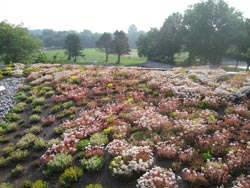More than four decades since the environment burst into the national consciousness with the first official Earth Day, words and phrases such as “sustainability,” “recycling” and “going green” have become part of our
lexicon — and central to our daily lives.
At Temple, environmental responsibility is continually being woven through the campus fabric; everywhere from academics, to research, to everyday business practices.
On Main Campus, the redesign of Pearson and McGonigle Halls to include a new upper level, will also feature the installation of approximately five 12-foot wind turbines on the roof. At full output, the turbines could generate between 16-18 kilowatts of power, which will be returned to the building's power grid, potentially reducing Temple’s energy costs.
In addition to the initiative’s environmental benefits, it also demonstrates the university’s commitment to using campus facilities as a living learning lab, as students from the College of Engineering have used the installation as a class project.
In a campus application of faculty research, Electrical and Computer Engineering Associate Professor Li Bai is testing four state-of-the-art LED street lights powered by conventional electricity as well as solar and wind power. The hybrid solar and wind-powered LEDs, which will be installed on campus for one to two years of testing, are much brighter than conventional street lights, have a longer life span and are more cost-efficient than current models. Bai estimates it would cost about $1,000 to retro-fit existing streetlights to use the LED, solar and wind-power technologies.
“Think about it: In this country there are a lot of street lights, especially in larger cities like Philadelphia,” he said. “Using this type of streetlight is one more way to make the U.S. more sustainable.”
A third project will incorporate stormwater management controls into new construction projects planned and underway across Main Campus.
A portion of a recent William Penn Foundation grant will allow Jeffrey Featherstone, professor and director of Temple’s Center for Sustainable Communities, and Laura Toran, professor of earth and environmental science in the College of Science and Technology, to install rain gauges and flow meters this summer at selected sites on the Main campus.
Working with facilities management and the campus sustainability committee, Featherstone and Toran will use the monitoring systems to evaluate the effectiveness of stormwater management controls being installed by the university.
Meanwhile, on the Ambler Campus, a new 12,000-gallon underground stormwater catchment system is being installed to collect and store rain water runoff, which will then be utilized to irrigate plants in the campus greenhouse.
Presently, a small amount of rain water is collected in barrels, and is used to water a few of the greenhouse plants. An additional 3,000 gallons of municipal water is used per week to sustain the remainder of the plants. The catchment system, which is being funded through a grant from the Pennsylvania Department of Environmental Protection, will capture rain water runoff from the greenhouse’s 6,600-square-foot roof.
“The sustainability factor is not only that we will be watering our plants with less alkaline, unchlorinated water, we’re also reducing the amount of stormwater runoff in this highly developed area and reducing the need for getting water from the local municipal water source,” said Sasha Eisenman, assistant professor of horticulture, who is collaborating on the cistern project with Horticulture and Ambler Arboretum Supervisor Grace Chapman.
Ambler is also home to Temple’s first “green” roof, which occupies about three-quarters of the 5,000-sq-ft roof atop the Intercollegiate Athletics Field House. It was installed in 2005 through a $50,000 grant from PECO Energy. A second “green” roof will be installed atop the new Architecture Building under construction on Main Campus.

